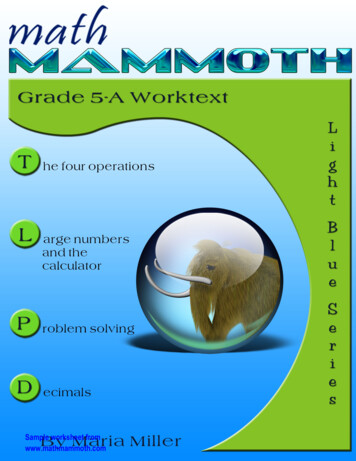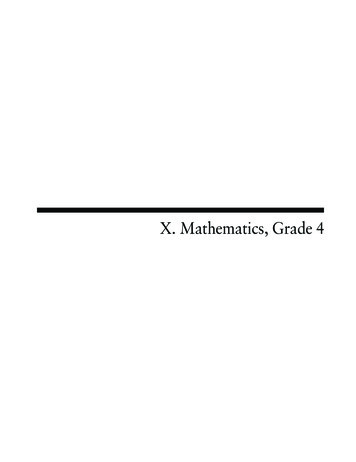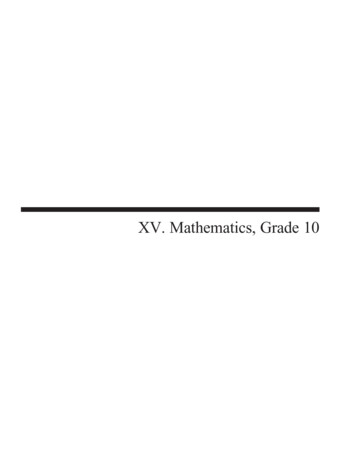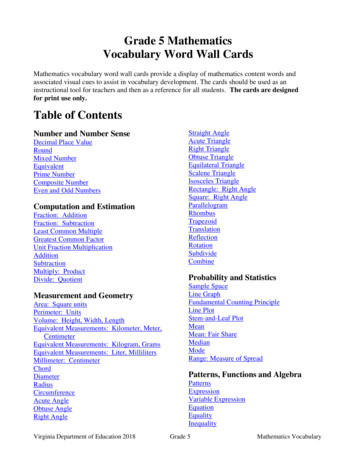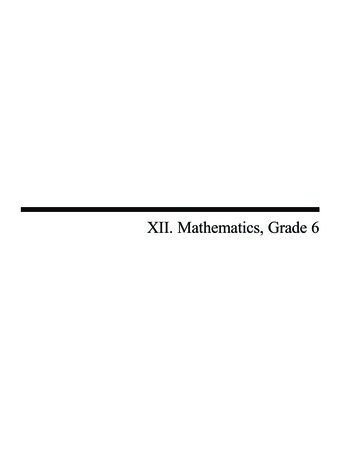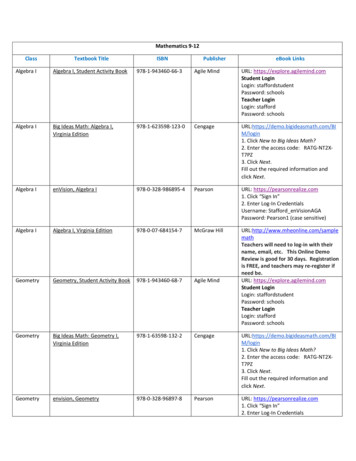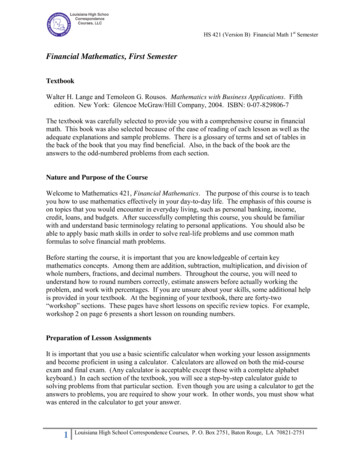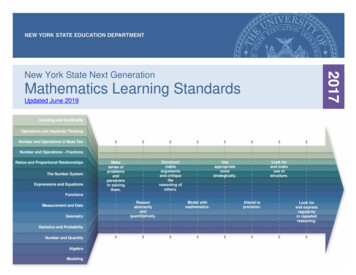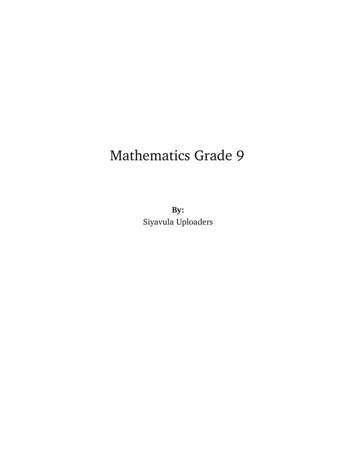
Transcription
Mathematics Grade 9By:Siyavula Uploaders
Mathematics Grade 9By:Siyavula UploadersOnline: http://cnx.org/content/col11056/1.1/ CONNEXIONSRice University, Houston, Texas
This selection and arrangement of content as a collection is copyrighted by Siyavula Uploaders. It is licensed underthe Creative Commons Attribution 3.0 license ection structure revised: September 14, 2009PDF generated: February 6, 2011For copyright and attribution information for the modules contained in this collection, see p. 208.
Table of Contents1 Term 11.1 Numbers - where do they come from? . . . . . . . . . . . . . . . . . . . . . . . . . . . . . . . . . . . . . . . . . . . . . . . . . . . . . . . 11.2 Easier algebra with exponents . . . . . . . . . . . . . . . . . . . . . . . . . . . . . . . . . . . . . . . . . . . . . . . . . . . . . . . . . . . . . . 121.3 Why all the fuss about Pythagoras? . . . . . . . . . . . . . . . . . . . . . . . . . . . . . . . . . . . . . . . . . . . . . . . . . . . . . . . . 191.4 How long is a piece of string? . . . . . . . . . . . . . . . . . . . . . . . . . . . . . . . . . . . . . . . . . . . . . . . . . . . . . . . . . . . . . . 281.5 Money Matters . . . . . . . . . . . . . . . . . . . . . . . . . . . . . . . . . . . . . . . . . . . . . . . . . . . . . . . . . . . . . . . . . . . . . . . . . . . . . 342 Term 22.1 The algebra of the four basic operations . . . . . . . . . . . . . . . . . . . . . . . . . . . . . . . . . . . . . . . . . . . . . . . . . . . . 412.2 Geometry of lines and triangles . . . . . . . . . . . . . . . . . . . . . . . . . . . . . . . . . . . . . . . . . . . . . . . . . . . . . . . . . . . . . 532.3 Space and shape . . . . . . . . . . . . . . . . . . . . . . . . . . . . . . . . . . . . . . . . . . . . . . . . . . . . . . . . . . . . . . . . . . . . . . . . . . . . 642.4 Congruency . . . . . . . . . . . . . . . . . . . . . . . . . . . . . . . . . . . . . . . . . . . . . . . . . . . . . . . . . . . . . . . . . . . . . . . . . . . . . . . . 722.5 Similarity . . . . . . . . . . . . . . . . . . . . . . . . . . . . . . . . . . . . . . . . . . . . . . . . . . . . . . . . . . . . . . . . . . . . . . . . . . . . . . . . . . 832.6 Worksheets . . . . . . . . . . . . . . . . . . . . . . . . . . . . . . . . . . . . . . . . . . . . . . . . . . . . . . . . . . . . . . . . . . . . . . . . . . . . . . . . . 923 Term 33.1 Number patterns . . . . . . . . . . . . . . . . . . . . . . . . . . . . . . . . . . . . . . . . . . . . . . . . . . . . . . . . . . . . . . . . . . . . . . . . . . 1013.2 Understanding what graphs tell us . . . . . . . . . . . . . . . . . . . . . . . . . . . . . . . . . . . . . . . . . . . . . . . . . . . . . . . . 1123.3 Understanding how equations are represented on a graph . . . . . . . . . . . . . . . . . . . . . . . . . . . . . . . . . . 1233.4 Finding the equation of a straight line graph from a diagram . . . . . . . . . . . . . . . . . . . . . . . . . . . . . . 1343.5 Solving simple problems by forming and solving equations . . . . . . . . . . . . . . . . . . . . . . . . . . . . . . . . . 1393.6 Collecting information to answer general questions . . . . . . . . . . . . . . . . . . . . . . . . . . . . . . . . . . . . . . . . . 1473.7 Analyse data for meaningful patterns and measures . . . . . . . . . . . . . . . . . . . . . . . . . . . . . . . . . . . . . . . . 1533.8 Extract meaningful information from data . . . . . . . . . . . . . . . . . . . . . . . . . . . . . . . . . . . . . . . . . . . . . . . . . 1623.9 Understanding the context and vocabulary of probability . . . . . . . . . . . . . . . . . . . . . . . . . . . . . . . . . . 1734 Term 44.1 Explore and identify the characteristics of some quadrilaterals . . . . . . . . . . . . . . . . . . . . . . . . . . . . . 1814.2 Compare quadrilaterals for similarities and di erences . . . . . . . . . . . . . . . . . . . . . . . . . . . . . . . . . . . . . 1874.3 Understanding quadrilaterals and their properties in problems . . . . . . . . . . . . . . . . . . . . . . . . . . . . . 1934.4 Drawing plan and side views of three-dimensional objects to scale . . . . . . . . . . . . . . . . . . . . . . . . . . 1964.5 Understand and use the principle of translation, learning suitable notations . . . . . . . . . . . . . . . . 200Attributions . . . . . . . . . . . . . . . . . . . . . . . . . . . . . . . . . . . . . . . . . . . . . . . . . . . . . . . . . . . . . . . . . . . . . . . . . . . . . . . . . . . . . . . . 208
iv
Chapter 1Term 11.1 Numbers - where do they come from?11.1.1 MATHEMATICS1.1.2 Grade 91.1.3 NUMBERS1.1.4 Module 11.1.5 NUMBERS WHERE DO THEY COME FROM?Numbers where do they come from?CLASS WORK1 Our name for the set of Natural numbers is N, and we write it: N { 1 ; 2 ; 3 ; . . . }1.1 Will the answer always be a natural number if you add any two natural numbers?How will youconvince someone that it is always the case?1.2 Multiply any two natural numbers. Is the answer always also a natural number?1.3 Now subtract any natural number from any other natural number. Describe all the sorts of answersyou can expect. Try to write down why this happens.2 To deal with the answers you got in 1.3, we have to extend the number system to include zero andnegative numbers we call them, with the natural numbers, the integers. They are called Z and this is oneway to write them down: Z { 0 ; 1 ; 2 ; 3; . . . }2.1 Complete the following de nitions by writing down what has to be inside the brackets: Counting numbers N0 {.}Integers Z {.} in another way!(Integersare also called whole numbers)3 Is the answer always another integer when you divide any integer by any other integer (except zero)?Toallow for these answers we have to extend the number system to the rational numbers:3.1 Q (rational numbers) is the set of all the numbers which can be written in the formab where a and bare integers as long as b is not zero. Explain very clearly why b is not allowed to be zero.4 Q (irrational numbers) is the set of numbers which cannot be written as a common fraction, and aretherefore not in Q. Putting Q en Q together gives the set called R, the real numbers.4.1 Write down what you think is in the set R . They are called non-real numbers.end of CLASS WORK1 Thiscontent is available online at http://cnx.org/content/m31203/1.1/ .1
CHAPTER 1. TERM 12Quipu is an Inca word meaning a string (or set of strings) with knots in it. This system was used forremembering things, mainly numbers. It was used widely in the ancient world; not only in South America.At its simplest, it was just one string with each knot representing one item. In more advanced systems, morestrings were used, often of di erent colours; sometimes a system of place-values was used.HOMEWORK ASSIGNMENT1. What is the importance of having a symbol for zero? Think about all the things we'll be unable to doif we didn't have a zero.2 Find out what we call the set of numbers we get when putting R and R together. Can you say moreabout them?3 Design your own set of number symbols like those in table 1. Show how any number can be written inyour system. Now think up new symbols for and and and[U F0B8],and then make up a few sumsto show how your system works.end of HOMEWORK ASSIGNMENTENRICHMENT ASSIGNMENTLet's check out the rational numbers Do the following sums on your own calculator to con rm that they are correct: Remember to do the operations in the proper order.1. 2 3[U F0B8]100 1 1[U F0B8]10 3,013Is 3,013 a rational number? Yes! Look at this bit of magic:133000133000 13 301331 1000 1000 1000 10001000It is easy to write it down straightaway. Explain the method carefully.3,013 Figure 1.14 Onlyterminatingandrepeatingdecimal fractions can be written in the form4.1 Here are some irrational numbers (check them out on your calculator):[U F010] 2 3 113,030030003000030. . .ab.
34.2 These are NOT irrational explain why not:22 ;7 25; 327Figure 1.2end of ENRICHMENT ASSIGNMENTWorking accuratelyCLASS ASSIGNMENT1 With every question, simplify the numbers, if necessary, and then place each number in its best positionon the given number line.Figure 1.3
CHAPTER 1. TERM 14Figure 1.4end of CLASS ASSIGNMENTENRICHMENT ASSIGNMENTInequalities translating words into maths1 The number line tells us something very important: If a number lies to themust be the smaller one. A number to therightleftof another number, itof another is the bigger.For example (keep the number line in mind) 4,5 is to the left of 10, so 4,5 must be smaller than 10.Mathematically: 4,5 10. 3 is to the left of 5, so 3 is smaller than 5. Mathematically speaking: 36 is to the right of 0, so 6 is bigger than 0 and we write: 6What about numbers that are equal to each other? Surely 6 So: 61.1[U F0B8] 3 Use or or 0 or 0[U F0B8] 56, because 0 is smaller than 6.3 and 4!4.between the numbers in the following pairs, without swopping the numbers around:5,6 and 5,7; 3 9 and 4 3; 1 and 2; 3 and 3 327 and 152 We use the same signs when working with variables (like x and y, etc.). .For example, if we want to mention all the numbers larger than 3, then we use an x to stand forallthosenumbers (of course there are in nitely many of them: 3,1 and 3,2 and 3,34 and 6 and 8 and 808 and 1 000000 etc). So we say: x 3.All the numbers smaller than 0: x Numbers larger than or equal to 6: x0. Like: 1 and 1,5 and 3,004 and 10 etc. 6. Write down ve of them.
5 All the numbers smaller than or equal to 2: x 2. Give three examples.2.1 Use the variable y and write inequalities for the following descriptions:All the numbers larger than 13,4 All the numbers smaller than or equal toπ3 We extend the idea further: All the numbers between 4 and 8: 4 x 8. We also say: x lies between 4 and 8.Numbers larger than 3 and smaller than or equal to 0,5: 3 xA is larger than or equal to 16 and smaller than or equal to 30: 16 0,5. A 30.It works best if you write numbers in the order in which they appear on the number line: the smaller numberon the left and the bigger one on the right. Then you simply choose between either3.1 Now you and a friend must each give three descriptions in words.inequalities for one another's descriptions.Inequalities graphical representations or .Then write the mathematicalOnce again we use examples 2 and 3 above, but this time we draw diagrams.
CHAPTER 1. TERM 16Figure 1.53.1 Again make your own diagrams.end of ENRICHMENT ASSIGNMENTGROUP ASSIGNMENT1 CALCULATORS ARE NOW FORBIDDEN DON'T DO ANY SUMS. ESTIMATE THE ANSWERSAS WELL AS YOU CAN AND FILL IN YOUR ESTIMATED ANSWERS. This assignment is the same asbefore only you have to draw your own suitable number line for the numbers. First work alone, then thegroup must decide on the best answer. Fill this answer in on the group's number line. This group e ort isthen handed in for marking. 4361222181 ;4 2 ; 9 4 11 1 ;11521.2 2.5 ½ ;; 1 ; ; 0,5 ; 0,05 ; 0,00533661.3 3 ; 3,5 ; 3,14 ; 22 [U F0B8] 7 ; 355 [U F0B8] 113 ; [U F010]1.1 8 ; 12 ; 5 11 ; 4 0 4 end of GROUP ASSIGNMENTCLASS WORK1 Of course one can write any number in many ways: 9 ;6 1; 327
7 4 and 8[U F0B8]16 and 2 2 are the same number! 41 are the same.4 and16500,5 and10 and 18 and 100 and51.1 Is 19 2 and 1 3 andq 6 2 and[U F0B8]3 equal to 1, 3̇? 5 the same as 2,2? Or1.2 IsWhat about1, 33̇?And 1,33 of 1,333 of 1,3?2,24? Or 2,236? Or 2,2361? Or maybe 2,2360? Discuss.1.3 Is 3 and 3,5 and 3,14 and 22 7 and 355 113 the same as[U F010]? Make a decision.2 We can't always write 3,1415926535897932384626 . . . when we want to use[U F010]. Why not?If I have to write down1.3 are onlyapproximatelyexactlyanswer, then I have to be able toThis isπwhatis, then I must write[U F010]equal to[U F010]. But when I have to useround o rounded o to di erent[U F010] ![U F010] inThe others in questiona calculation to get anproperly.degrees of accuracy :1 decimal place: 3,12 decimal places: 3,143 decimal places: 3,1424 decimal places: 3,14165 decimal places: 3,141596 decimal places: 3,141593 You mustnowensure that you know how to do rounding o correctly.3 Simplify and round o the following values, accurate to the number of decimal places given in the brackets.3.1 3,1[U F0B8]3 (2) 2 2)5 [U F010] (2) 4,5 7 (0)1,000008 25 [U F0B8]3.2 23.33.43.510000 (1)end of CLASS WORKHow many seconds in a century?CLASS WORK1.1 How many hours are there in 17 weeks? 241.2 How many minutes in a week? 60 24 717 2 856 hours7 10 080 minutes1.3 Is it just as easy to calculate how many hours there are in 135 months? Discuss the question in agroup and decide which questions have to be answered before the answer can be calculated.1.4 How many years are there in 173 months? 173 The [U F0B8]12 14,41666̇ 14,42 yearssign means approximately equal to and is sometimes used to show that the answer has beenrounded. It isn't used a lot, but it is a good habit.2 Why do wemultiplyin question 1.1 and 1.2, anddividein question 1.4?3 How many seconds in a century? It may take a while to get to the answer! How will you know thatyou can trust your answer?4.1 There are one thousand metres in a kilometre, so we can say that one metre equals 0,001 kilometres.One metre 1[U F0B8]1000 kilometres or 1 m 11000 km4.2 There are one thousand millimetres in a metre: 1 mm 4.3 There are one thousand micrometres in a millimetre: 111000 1000 km 0,000 001 kmµm 0,000 000 001 km. (µ is a Greek letter mu.)5 Just as we can write very large numbers more conveniently inscienti c notation,we also write verysmall numbers in scienti c notation. Below are a few examples of each. Make sure that you can convertordinary numbers to scienti c notation, and vice versa.Calculators also use a sort of scienti c notation.They di er, and so you have to make yourself familiar with the way your calculator handles very large andvery small numbers.5.1 1µm 0,000 000 001 km So: 1µm 1,0 10 9 km
CHAPTER 1. TERM 18 The de nition of alight yearis the distance that light travels in one year. Because light travels veryfast, this is a huge distance. A light year is approximately 9,46 12 km. Write this value as an10ordinary number. An electron has a mass of approximately 0,000 000 000 000 000 000 000 000 000 91g. What does thisnumber look like in scienti c notation?5.2 On a typical lightweight bed sheet, there might be about three threads per millimetre, both across andlengthwise. If a sheet for a double bed measured two metres square, that would mean 6,0across plus another 6,0 310 threads lengthwise. That gives us 1,2 103 threads410 threads, each about two metreslong. Calculate how many kilometres of thread it took to make the sheet. Tonight, measure your pillowslipand do the same calculation for it. 5 litres of water. In parts of South Africa the annual12 raindrops per year. On a largish cityrainfall is about 1 metre. On one hectare that means about 1 10167that could mean about 6 10raindrops per year, or about 1 10 drops for every man, woman and child5.3 A typical raindrop might contain about 1 10on Earth. How many litres each is that?5.4 Calculate: (give answers in scienti c notation)3,501 10 5 119,5 10 8 4, 3 103,5 106 1,4 10 175.4.23,5 106 1,4 10 175.4.1end of CLASS WORKWe use pre xes, mostly from Latin and Greek, to make names for units of measurement. For example,the standard unit of length is themetre.When we want to speak of ten metres, we can say one decametre;one hundred metres is a hectometre and, of course, one thousand metres is a kilometre.One tenth of ametre is a decimetre; one hundredth of a metre is a centimetre and one thousandth is a millimetre. Thereare other pre xes see how many you can track down.Your computer pals will be able to con rm, I hope, that in computers a kilobyte is really 1024 bytes .Now, why is it 1024 bytes and not 1000 bytes? The answer lies in the fact that computers work in the binarysystem and not in the decimal system like people. Try to nd the answer yourself.1.1.6 AssessmentLearning outcomes(LOs)LO 1Numbers, Operations and RelationshipsThe learner will be able to recognise, describe and represent numbers and their relationships, and to count, estimate, calculate and check with competence and con dencein solving problems.Assessment standards(ASs)We know this when the learner :continued on next page
91.1 describes and illustrates the historical development of number systems in a variety of historical andcultural contexts (including local);1.2 recognises, uses and represents rational numbers (including very small numbers written in scienti cnotation), moving exibly between equivalent forms in appropriate contexts;1.3 solves problems in context including contexts that may be used to build awareness of other learningareas, as well as human rights, social, economic and environmental issues such as:1.3.1 nancial (including pro t and loss, budgets, accounts, loans, simple and compound interest, hirepurchase, exchange rates, commission, rentals and banking);1.3.2 measurements in Natural Sciences and Technology contexts;1.4 solves problems that involve ratio, rate and proportion (direct and indirect);1.5 estimates and calculates by selecting and using operations appropriate to solving problems and judgingthe reasonableness of results (including measurement problems that involve rational approximations ofirrational numbers);1.6 uses a range of techniques and tools (including technology) to perform calculations e ciently and tothe required degree of accuracy, including the following laws and meanings of exponents (the expectationbeing that learners should be able to use these laws and meanings in calculations only):1.6.1 xn 1.6.2 xn[U F0B8]1.6.3 x0 11.6.4 x n 1xnxm xn mxm xn m1.7 recognises, describes and uses the properties of rational numbers.Table 1.11.1.7 MemorandumCLASS WORK1.1 Yes, any informal proof is acceptable.1.2 As 1.11.3 Zero and negative numbers make an appearance. The explanation is not important only the thinkingthat the learner does.2.1 N0 {0 ; 1 ; 2 ; . . . } andZ { . . . 3 ; 2 ; 1 ; 0 ; 1 ; 2 ; 3 ; . . .}3. Here are the fractions. Explain carefully that integers can also be written as fractions in fact it isquite often a useful technique.4.1 Not everyone will be able to cope with this.R gives the answers that are obtained when square rootsof negative numbers (inter alia) is taken.TASK2. Point out to learners that zero is missing from the table.HOMEWORK ASSIGNMENT1. Zero is needed because:The principle behind place values is totally dependent on having a symbol for zero.It separates positive and negative numbers.It symbolises nothing .Algebraically it is de ned as:a ( a)2. Complex numbers don't expect too much.
CHAPTER 1. TERM 110 1,symbol i for If one uses the2 3 1 2 3 1 2 3ithen we can represent non real numbers as follows: 12 2 3 3 5i and 2,5 16i are examples of non real numbers, and each consists of two parts: a real part and anon-real part. The most important consequences of this are that one must be careful when doing arithmeticcalculations, and that these numbers cannot be arranged in ascending order!3. Any reasonable answer can be accepted. This might be a good opportunity to have learners evaluatingeach other's number systems.ENRICHMENT ASSIGNMENTIf there is time, one can go through this work, particularly with a strong group.4.1 Non-repeating; although 3,030030003000030. . . has a pattern, it does not repeat.4.2 Emphasise that the rst one is NOT equal to15531000514.3.290303114.3.399924034.3.4990π.The two others must be simpli ed properly.4.3.1CLASS ASSIGNMENTThe aim of this exercise is to familiarise learners with unsimpli ed values, so that they can learn toestimate.It is very important that they mentally simplify correctly so that they can start guessing themagnitudes. Then the values have to be arranged in at least the correct order. If the spaces in between arein reasonable proportion, that is a bonus. This shows the order:1.1 0,00 ; 1 ; 2 ; 3,0 ; 4 ; 5,0000 ; 5 2 ; 6 ; 9 11.2 4 ; 3 ; 1 ; 3 3 ; 2 ; 5115 ; 4 ; 0.666 ;31.42 12 ; 8 223 ; 2 ; 1,000 ; 0,2 1 ; 1.7575145 ; 5,5 ; 2 ; 2,5 ; 5,55 ; 2 q 9 16 ;0 ; 1 ; 4 ; 2 ; 9 ; 36 11.31.51.6 9; 4 4 ; 6 ; 9 ; 16 ; 25 ; 20 1 ; 32 ; 36ENRICHMENT ASSIGNMENT 5,7; 3 9y 13,41.1 5,62.1 4 3; 1 2; 3 3; 327 15
11Figure 1.6GROUP ASSIGNMENTThese are the simpli ed values in the original order:1.1 8 ; 12 ; 6 ; 2 ; 10 ; 3 ; 5 ; 3,44. . . ; 31.2 2 ; 0,3. . . ; 1,3. . . ; 0,5 ; 0,5 ; 0,05 ; 0,0051.3 3 ; 3,5 ; 3,14 ; 3,142857. . . ; 3,1415929. . . ; 3,1415926. . . (the last one isπ)These are the same values in the correct order:1.1 8 ; 6 ; 2 ; 3 ; 3,44. . . ; 5 ; 10 ; 121.2 0,005 ; 0,05 ; 0,3. . . ; 0,5 ; 1,3. . . ; 21.3 3 ; 3,14 ;π; 3,1415929. . . ; 3,142857. . .CLASS WORKThis exercise has been designed to give learners a feeling for the consequences of rounding (approximatedanswers). They often put complete unthinking faith in their calculators' answers.1.1 Note the notation as well as the number of decimal places.1.2 Again, notation as well as number of decimal places.1.3 Emphasise once again that an approximation toπis notequaltoπ.Discuss the meaning of the term approximately equal to .3. Answers: 1,03 ; 2,83 ; 15,71 ; 12 ; 1,0 (the zero must be there).CLASS WORKLearners often have di culties with conversions you might have to supply lots of help and guidance.1.3 The months don't have the same number of days; simply multiplying will not give the best answer.Find out which months are meant and don't forget leap years!1.4 Why division? Help them develop strategies.3. Similar problems to 1.3. The answer can be approximated. Explain why this acceptable. This problemwill motivate them to appreciate the advantages of scienti c notation:5.1 9,1 28105.2 24 km5.3 100 litres 3 157 056 000 seconds.
CHAPTER 1. TERM 112Figure 1.71.2 Easier algebra with exponents21.2.1 MATHEMATICS1.2.2 Grade 91.2.3 NUMBERS1.2.4 Module 21.2.5 EASIER ALGEBRA WITH EXPONENTSEasier algebra with exponentsCLASS WORK Do you remember how exponents work? Write down the meaning of three to the power seven . Whatis the base? What is the exponent? Can you explain clearly what a power is? In this section you will nd many numerical examples; use your calculator to work through them todevelop con dence in the methods.1 DEFINITION3 22also 2 4 a 2 and a3 (a b)a a a and b b 2 4 23 31.1 Write the following expressions in expanded form:(a b) (a b) 3 ; (p 2)5 ; a1 ; (0,5)7 ; b24 (a b) and 3b b23 23 23 3 ;b1.2 Write these expressions as powers: 7 7 7 y y y y 2 2 2(x y) (x y) (x y) 7y(x y)1.3 Answer without calculating: Is ( 7) Now use your calculator to check Compare the following pairs, but6 the same as 76 ?whether they are the same.rst guess the answer before using your calculator to see how goodyour estimate was.2 and ( 5)2 125 and ( 12)5 13 and ( 1)3 5 By now you should have a good idea how brackets in uence your calculations write it down carefullyto help you remember to use it when the problems become harder. The de nition is:r aa 2 Thisa a a . . . (There must be r a's, and r must be a natural number)content is available online at http://cnx.org/content/m31943/1.1/ .
13 It is good time to start memorising the most useful powers:2 4; 23 8; 24 16; etc. 32 9; 33 27; 34 81; etc. 42 16; 43 64; etc.2Most problems with exponents have to be done without a calculator!2 MULTIPLICATION Do you remember that g3 8 g11 ? Important words: multiply; same baseg2.1 Simplify: (don't use expanded form)7 74( 2)77 ( 2)13 ( ½ )2 ( ½ab(a b) (a b)1( ½ )xa)3 We multiply powers with the same base according to this rule: ay ax y alsoax y ax ay ay ax ,814 84 810e.g.3 DIVISION4642 46 2 443.1 Try these: is how it works. Important words: divide; same base(a b)pa6 323a7ay ; 321 ; (a b)12 ; a7The rule for dividing powers is:axay ax y .axa207ay , e.g. a a134 RAISING A POWER TO A POWERx yAlsoa e.g. 32 4 32 4 38 .4.1 Do the following:Figure 1.8 This is the rule:(ax ) axy alsoaxy (ax ) (ay )yyx, e.g.618 66 35 THE POWER OF A PRODUCT (2a) This is how it works:3 (2a) (2a) (2a) 2 a 2 a 2 a 23 23It is usually done in two steps, like this: (2a) 2 2 3 8a3aa a 3a 8a
CHAPTER 1. TERM 1145.1 Do these yourself: (4x) 2 ; (ab)6 ; (3 4 ; ( ½ x)2 ; (a2 b3 )22)It must be clear to you that the exponent belongs to each factor in the brackets.The rule: (ab)x ax bx alsoapb bp (ab)e.g. 14332 (2 7) 23 73 and32 42 (3 4) 1226 A POWER OF A FRACTION This is much the same as the power of a product.6.1 Do these, but be careful: 2 p3 ( 2)2 3 x2y3 2 a xb y a 3b a3b3 2 Again, the exponent belongs to both the numerator and the denominator. The rule: a mb amambm and bm a me.g.b 2 33 23338 27anda2xbxx (a2 )bx a2b xend of CLASS WORKTUTORIAL 1.Apply the rules together to simplify these expressions without a calculator.x3 y 4 x2 y 5a a74 8a a8 2. x y 2 22 3 23. a b c ac55.32 (bc) 4. a3 b2 aa 3 2(x2 y)23 22 27(2xy) 2x2 y 4 (2xy)3 6. 8 4 8 2 8b5b43 (ab)end of TUTORIALSome more rulesCLASS WORKa5a31 Consider this case: a5 3 a2Discuss the following two problems, and make two more rules to cover these cases.a3a31.1 3 1.2 5aa2 WHEN THE EXPONENT IS ZERO The answer to 1.1 is aBut weknow0 when we apply the rule for division.that the answer must be 1, because the numerator and denominator are the same.So, we can say thatThe rule is now: aanythingwith a zero as exponent must be equal to 1.0 1 also 1 a0 . A few examples:0 1; k0 1; (ab2 )0 1 ; (n 1)0 1;3 a3 b(ab2 )2 0 1and01 (anything) , in other words, we can change a 1 to anything that suits us, if necessary!3 WHEN THE EXPONENT IS NEGATIVE ab 2 . But what does it mean?Look again at 1.2. According to the rule, the answer is aa3a a a11a5 a a a a a a a a2 .1 xSo the rule is: a ax and vice versa.From now on we always try to write answers with positive exponents, where possible.The rule also means:c abc32x m y 2 31a x ax andvice versa. These examples are important:22yxma2 a3a5a2 b 5 a 3 b5b5 b5b10end of CLASS WORKHOMEWORK ASSIGNMENT(1.1)
15 1.Simplify without a calculator and leave answers without negative exponents.x3 y 2 32 x2 y 2xy44x2 y 47 3x46x22.3xy2 x3 y 2x y 2y x 33 x3. (5 ) 5 2 32 5 3 24. 2a b c d 2a bc2 d 4ab cd3 2 2 34x5. 6 2x 3xxyyy3 02 36. 2a 12a3 8a6 3 23 47. x y 3 1 x2 y 1 2xy3end of HOMEWORK ASSIGNMENTCLASS WORK Let us make sure that we can replace variables with numerical values properly.1 To calculate the perimeter of a rectangle with side lengths 17cm and 13,5 cm, we use normal formula: Perimeter 2 [ length breadth ] Put brackets in place of the variables: 2 [ ( ) ( ) ]Fill in the values: 2 [ (17) (13,5) ]Remove brackets and simplify 2 [ 17 13,5 ]according to the rules: 22 What is the value of 20,5Remember the units (if any): 41 cmx3 y 4 x2 y 5if x 3 and y 2 ?x4 y 8There are two possibilities: rst substitute and then simplify or simplify rst and then substitute. Hereare both methods:(3)3 (2)4 (3)2 (2)5x3 y 4 x2 y 527 16 9 32 3 2 6 x4 y 881 128(3)4 (2)832455342 5x x y yx y 9x y x y5 4 4 y 9 8 x y (3)x4 y 8x4 y 8x y 8 x (2) 6Without errors, the answers will be the same.3.1 Calculate the perimeter of the square with side length 6,5 cm3.2 Calculate the area of the rectangle with side lengths 17 cm and 13,5 cm.3.3 If a 5 and b 1 and c 2 and d 3, calculate the value of:2a2 b5 c3 d 2 2a2bc 3d 4ab 3 2cdend of CLASS WORKAssessmentExponentsωI can . . .ASsRecognise which rules to use1.6Simplify expressions with exponents2.8Give answers with positive exponents1.6.4Use scienti c notation1.6.1Do substitutions1.6Apply formulae1.6[U F04A][U F04B][U F04C]Now I have to . . . .
CHAPTER 1. TERM 116Table 1.2[U F04A] good [U F04B] average [U F04C] not so goodFor this learning unit I . . .Worked very hardyesnoNeglected my workyesnoDid very little workyesnoDate :Table 1.3Learner can . . .ASsRecognise which rules to use1.6Simplify expressions with exponents2.8Give answers with positive exponents1.6.4Use scienti c notation1.6.1Do substitutions1.6Apply formulae1.61234Comments1234Table 1.4Critical outcomesCooperative group workCommunication using symbols properlyAccuracyUnderstanding of Maths in everyday lifeTable 1.5Educator:Signature:Date :Table 1.6Feedback from parents:Signature:Date :Table 1.71.2.6 Assessment
17Learning outcomes(LOs)LO 1Numbers, Operations and RelationshipsThe learner will be able to recognise, describe and represent numbers and their relationships, and to count, estimate, calculate and check with competence and con dencein solving problems.Assessment standards(ASs)We know this when the learner :1.1 describes and illustrates the historical development of number systems in a variety of historical andcultural contexts (including local);1.2 recognises, uses and represents rational numbers (including very small numbers written in scienti cnotation), moving exibly between equivalent forms in appropriate contexts;1.3 solves problems in context including contexts that may be used to build awareness of other learningareas, as well as human rights, social, economic and environmental issues such as:1.3.1 nancial (including pro t and loss, budgets, accounts, loans, simple and compound interest, hirepurchase, exchange rates, commission, rentals and banking);1.3.2 measurements in Natural Sciences and Technology contexts;1.4 solves problems that involve ratio, rate and proportion (direct and indirect);1.5 estimates and calculates by selecting and using operations appropriate to solving problems and judgingthe reasonableness of results (including measurement problems that inv
5,6 and 5,7; 3 9 and 4 3; 1 and 2; 3 and 3 3 p 27 and p 15 2 We use the same signs when working with ariablevs (like x and ,y etc.). . orF example, if we want to mention all the numbers larger than 3, then we use an x to stand for all those numbers (of course there are in nitely many of them: 3,1 and 3,
